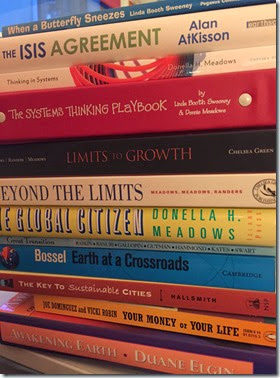I saw this first last year at the Balaton Group Meeting where Junko Edahiro, a fellow life-long learner and enthusiast in the field of productivity, was using her “nu board” to take notes during the meeting. I usually use my iPad and Penultimate to take photos, written notes with my stylus etc, etc. and they sync to my Evernote account so I can search them later. (See our blog post “Fast and Easy Workshop Reports with Penultimate“.) But as soon as I saw the nu board, I knew I had to have one! (Thanks to my Japanese Balaton Group friends for their kind gift – they are made in Japan!)
If you were sitting next to me in The School of Life gathering in London (on the timely topic of keeping New Year’s Resolutions) last week, you would have seen me taking notes in my small nu board with a thin black marker, filling a page with notes, taking a photo of the page with my phone (I was actually putting it into my mobile Evernote app), then erasing the whole page with the top of my pen (a mini white board eraser), and start writing again. I did this again and again throughout the 2-hour event.
The nu board (available in A4 and A5 size), is effectively a bound book of thin white boards. In between each board is a transparent page that you can either write on to overlay additional text/drawings, or use it to protect your previous page from wrist smears. You simply write with the nice thin marker (the board comes with the white one below, and the blue nu board pens, available separately, have a harder and thinner nib for even crisper writing)…
Then you take a photo of your page (as I mentioned I put mine into Evernote, but you might keep photos in a different database system) and then simply use the top of the marker that comes with your nu board to erase the page (its very easy to erase if you do it right away, if you wait you need to use some elbow grease)…
…and you start writing again. There are 4 whiteboard pages in each nu board, so you can take 8 pages of notes before you need to take your photos if you want. I had just cleared one page when I was at the School of Life, as I had not yet processed the other pages (which were from the terrific TEDxPlaceDesNations I wrote about in the previous post), but the pace of the TSoL event made that fine.
There is also a separate unbound, single page A4 nu board that I was told could be used, for example, during workshops or conferences to keep time for speakers (e.g, writing up 5 MINUTES), or give instructions to people at a distance (CLAP! – just kidding). I look forward to thinking up interesting ways to use that too.
Nu board is a very clever and simple idea. It is a paper-free solution that takes away the problem of having a bunch of handwritten notes after a workshop or meeting that you need to store somewhere (of course you can take a photo of those too, but then why use the paper?) The improvement on my iPad is that the pen is thinner and I can take denser notes on the paper (the stylus I have for Penultimate is thicker so your writing is bigger, thus less words on each page – fine in some contexts, less so in others).
The mobile photo archiving is high tech, but the nu board is wonderfully tangible and low tech in your hands, giving you the satisfaction of writing, drawing and decorating your notes page, just like you did at school – but you don’t ever have to torment yourself about whether or not to throw those old school notebooks away. Presto! with a swipe, its all gone into your digital archive…
(If you want another reason to try something like this, have a look at this LifeHack article Here’s Why You Should Take Notes By Hand (instead of with a laptop) which discusses a new Princeton/University of California study that shows that those who hand write their notes learn more than those who take notes on their laptops!)











